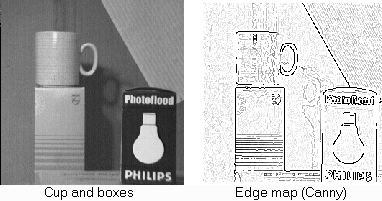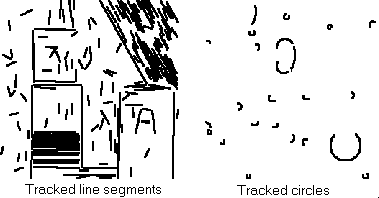 Edge tracking and fitting
Edge tracking and fitting
of line and arc segments

As a further example, we show an approach which tracks edge data in a local neighbourhood, yet fits straight line and circular arc segments
as it proceeds. It is a three pass algorithm, which operates on thinned edge data. The algorithm is not described in detail; a description
can be found in ``Robust segmentation of edge data'' in the Proc. of the 4th IEE International Conf. on Image Processing, 1992, written by A. Etemadi.
-
Segmentation Pass: the usual way to segment a chain of pixels is by examination of curvature. This algorithm proceeds in a slightly
diferent manner; the chained sets of pixels are broken into subsets which are near-symmetric about an axis passing through the midpoint of the subset, but perpendicular to the line joining the end points.
-
Linking Adjacent Segments: a least squares fit is performed on segment points. If adjacent segments are to be merged, then they
must have the same relative direction and radius of curvature, to within a specified tolerance. A new fit may be performed on the
linked data and the process repeated.
-
Classification: this is done by a simple heuristic, checking the deviation of the central point from a straight line joining the end
points. Segments are classified as straight or circular.
Figures 5 and 6, below, show an example of the algorithm applied to a test image. Here, line or arcs of less than 10 pixels are rejected.

Figure 5: The test image

Figure 6: Edge tracking and fitting


[ Feature space transformation for line detection |
Representation of two-dimensional boundaries ]

Comments to: Sarah Price at ICBL.
(Last update: 22th April, 1996)






